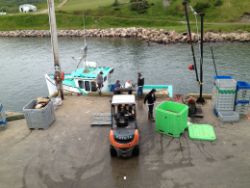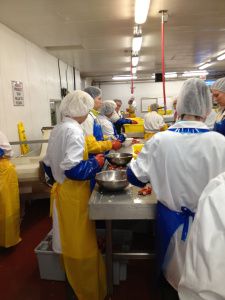Halifax Media Co-op
News from Nova Scotia's Grassroots
Exploring the Victoria Fisheries Co-operative, by Susanna Fuller
This blog was originally posted at Small Scales, the excellent East Coast fisheries blog administered by the Marine Issues Committee of the Ecology Action Centre.
This summer, I had the pleasure of visiting the communities of Bay St. Lawrence and Neil’s Harbour in Northern Cape Breton where I dropped in on the Victoria Fisheries Co-op. Both communities have unloading facilities and Neil’s Harbour has a modern processing plant. The Co-op buys from eight communities and processes $15 to 20 million dollars worth of fish a year.
Life in these communities is tightly tied to the sea, and the ebbs and flows in fisheries resources are mirrored by ebbs and flows in the human population – both in the number of people who have the luxury of living “home” and generally in people’s sense of well-being.
During the summer months, the wharves and the plant are beehives of action, where catches are landed, boats loaded, gear repaired and gossip shared. A boat landed lobster as we looked out over the wharf, and two of the fishermen we’d seen the night before playing music in a church basement. Big grey ice bins dotted the landscape, ready for the placement of fresh fish and lobster.
The facility in Bay St. Lawrence also acts as a general store of sorts, with rubber boots, foul weather gear, and hydraulic fluid all available for purchase. Hidden away at the back of the plant is a freezer, partly filled with ice cream and the rest filled with vacuum-sealed packages of locally caught and processed crab and lobster meat.
On the back wall of the building is a gallery of photos depicting proud fishermen with 300 pound halibut, wild salmon, 30 inch cod– all yellowed and dusty with age, reminiscent of the old days when large fish were plentiful.
One of my favorite — and one of the most elusive — experiences of the summer, is eating crab legs, just off the boat and still hot from being steamed on the wharf. These days, the crab quota is so quickly caught – within a few weeks — that unless you are there at the right time, you’ve lost your chance for a “feed.” The crab catch gets processed for export and shipped out immediately.
At the processing plant in Neil’s Harbour (about 45 minutes from Bay St. Lawrence) I took advantage of the packages of crab and lobster and loaded up a cooler to bring back home for the winter. To pay, we had to go down the road and up the hill to the head office of the Co-op, which is in the former elementary school building.
A basic financial transaction is made interesting, but difficult. The plants I’d visited in theMagdelen Islands a few summers ago had small seafood restaurants and direct sales, and I wondered why the same did not exist here.
After donning sterilized footwear, hair-nets and disposable lab coats, we were led through the plant by the quality and control manager, who comes each year from Newfoundland for the “season”.
This year, the plant was short 20 people during the rush to process the lobster and crab. Today’s market demands that the shellfish be processed as soon as they come in. It is hard work, standing for hours at a time, but the camaraderie and spirit in the plant is palpable. If the labour shortage cannot be sorted out next year, they will consider more automation.
The processing tables are full of bowls of fresh lobster meat, with Styrofoam trays of unshelled, uniformly sized lobster claws destined for high-end markets in Japan, where they sell for $40.00 per pound. This summer, fishermen have been struggling to survive with prices at the wharf ranging from $3.00 -$3.75 per pound for market size lobsters.
All lobster bodies and shells are discarded. They leave the plant on a conveyor belt, flushed by seawater into large bins waiting outside that are then taken to the local landfill a couple of miles away. Some are composted, and available for community use, but it seems like so much more could be done to improve the overall revenues of the co-operative and to make the most use of this resource produced for us by the sea.
Today, as I carefully break the seal on one of my precious crab meat packages, I am reminded of the smiles and efficiency of the plant workers, the direct connection to the fishermen and the importance of these local co-operatives for coastal communities. The co-operative is an incredible asset in Northern Cape Breton and its success over the years is a testament to the fishermen and communities it serves.
And yet, my mind continues to churn at how we might further improve this story. How can we use the waste stream? Can we better develop the access to local markets and tourists? Are we truly maximizing the potential benefit of our fisheries resources? What can be done to improve prices at the wharf to ensure that fishing at the community level remains a sustainable livelihood?
Susanna Fuller grew up in Cape Breton and spent time on lobster boats in her formative teenage years. She is currently the Marine Conservation Coordinator at the Ecology Action Centre.
The site for the Halifax local of The Media Co-op has been archived and will no longer be updated. Please visit the main Media Co-op website to learn more about the organization.





